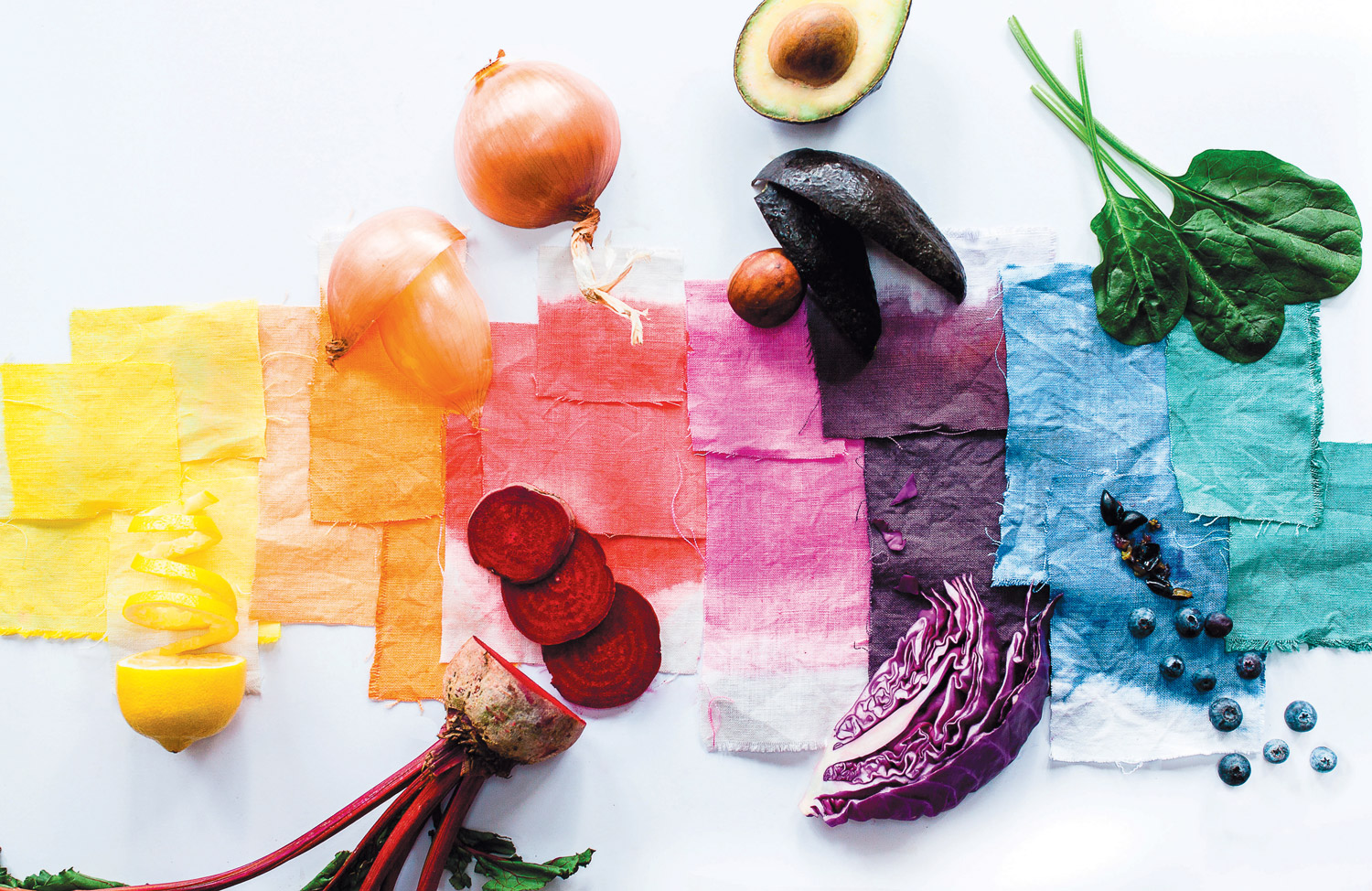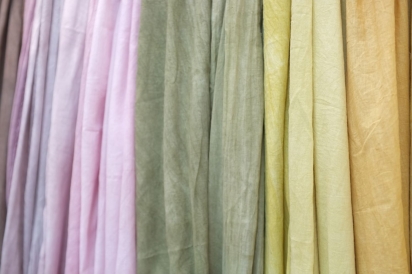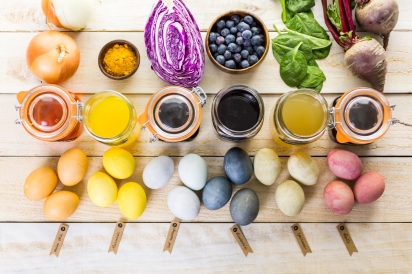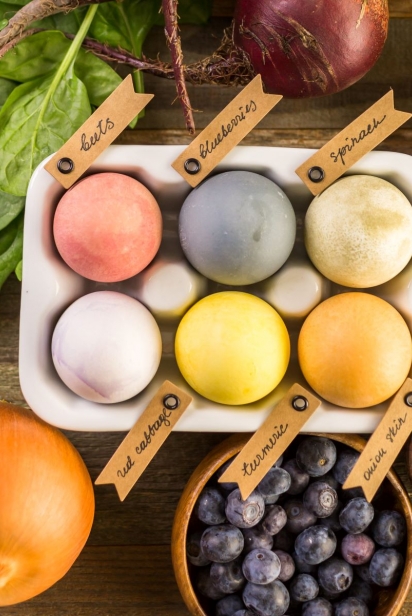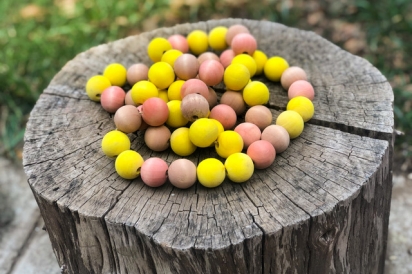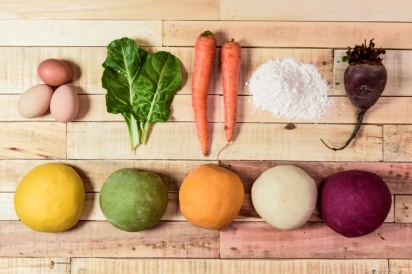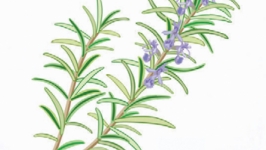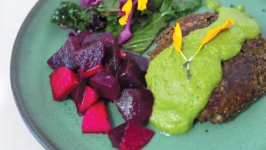True Colors: From Food to Dye
CREATING NATURAL COLORFUL DYES AT HOME
From home gardens to large farms, fresh local produce grown all around Ventura County can be enjoyed in delicious meals, but what becomes of the food scraps left over? Before we toss the scraps into our worm bins and compost heaps, produce scraps can be utilized to create natural dyes for natural fabrics, crafts, and baked goods.
The use of natural dyes dates back to ancient times; even the Egyptians used marine algae found on rocks in the Mediterranean Sea as dyes in garments and bandages. Today, many of us use natural dyes because of their less harmful effects on our health and the natural environment.
Use this how-to guide to learn more about creating natural dyes at home for you and your family.
DYEING FABRICS
Safety Tips:
When creating beautiful natural dyes for fabrics it is always important to follow some simple rules.
- Never use the same pots and utensils for dyeing that you use in the kitchen for cooking or baking
- Wear rubber gloves, an apron, and a dust mask when measuring out mordants (fixatives) as they can sometimes be irritating to the nose, throat, or skin.
- Adult supervision is strongly recommended when working with children.
- Always work in a well-ventilated space
- Dispose of the used mordants and dyes safely. The mordants used in this guide are labeled GRAS (Generally Recognized as Safe) by the FDA and can be safely disposed of through the municipal water system by being poured down the drain. They should never be disposed in water ways or drains that flow into waterways.
Preparing Fabrics with a Fixative:
When dyeing fabrics, a little preparation is needed before adding the natural dye solution. Fabrics need a fixative, a chemical substance used to stabilize or set biological material (natural plant dyes) on to either cellulose (plant) or protein (animal) fabrics. An important note to remember is that natural dyes only works well on natural fabrics, they do not adhere well to synthetics, which need to undergo a photosensitized oxidation process.
Some plants have tannins, a substance that occurs naturally and eliminates the need for fixatives when dyeing fabrics. The produce table at the end of the guide notes which vegetables or fruits have tannins.
Many natural dyes require the use of a mordant, a fixative that allows dye molecules to bind to fiber. Natural dyes will eventually fade out or wash away, the use of salt (sodium chloride) or vinegar delays the fading process.
Mordanting Fabrics for Fruit Dyes
Ingredients
- 1/4 cup of salt
- 4 cups of water
Instructions
- Simmer natural fiber fabric in the salt and water mixture (be sure fabric is fully submerged)
- Allow it to boil for 1 hour
- Rinse in cold water
- Fabric is ready for dyeing Mordanting Fabrics for Vegetable Dyes
Ingredients
- 1 cup of vinegar
- 4 cups of water
Instructions
- Simmer natural fiber fabric in the vinegar and water mixture (be sure fabric is fully submerged)
- Allow it to boil for 1 hour
- Rinse in cold water
- Fabric is ready for dyeing
Dyeing Mordanted Fabrics:
Ingredients/Supplies
- Select Produce (Avocados, Beets, Spinach, Red Cabbage, Onion) Based on Desired Color
- Saucepan or Pot (used only for dyeing)
- Wood Spoon (used only for dyeing)
- Water
Instructions
- Chop up at least 1 cup of desired produce (again this depends on the color you desire, produce can be combined to yield different shades)
- Add all chopped ingredients to a small saucepan or pot with twice as much water as produce.
- Place over medium heat and bring to a simmer for one hour.
- Turn off the heat and let the water come to room temperature then strain off and remove all produce bits
- Add rinsed mordanted fabrics to the natural dye
- Gently stir your fabric or yarn, be sure fabric or yarn is completely submerged
- When desired color is reached remove fabric or yarn from the pot and allow the excess dye to drain back into the pot
- Place dyed fabric into a container filled with clean water and let it soak for a couple minutes
- Rinse a second time with another container of clean water
- Remove fabric or yarn from the rinse container and hang to dry outside
*Note slowly bring up the temperature for reds, do not let them hit boiling or the color will result in a brownish to grayish shade. Yarn should not be floating and air bubbles should be pressed out of any fabric folds when in the dye pot.
NATURAL DYES FOR CRAFTS
Natural dyes using produce can also be used to stain wooden crafts or dye hard boiled eggs. The instructions for dyeing these items are very similar to dyeing fabrics. Please follow the safety tips used for dyeing fabrics when dyeing wooden crafts and hard boiled eggs.
Ingredients/Supplies
- Select Produce (Avocados, Beets, Spinach, Red Cabbage, Onion) Based on Desired Color
- Saucepan or Pot (used only for dyeing)
- Wood Spoon (used only for dyeing)
- Water
Instructions
- Chop up at least 1 cup of desired produce (again this depends on the color you desire, produce can be combined to yield different shades)
- Add all chopped ingredients to a small saucepan or pot with twice as much water as produce.
- Place over medium heat and bring to a simmer for one hour.
- Turn off the heat and let the water come to room temperature then strain off and remove all produce bits
- Mix the dyed solution with a mordant such as vinegar (for every 1 cup of solution use 1 to 2 Tbsp of distilled white vinegar)
- Submerge wood or hard boiled eggs into the vinegar/dye solution for 30 minutes or until desired color is reached.
- Rinse of hard boiled egg or wood piece in cold water and leave out to dry
CONCENTRATED NATURAL DYES FOR BAKED GOODS
Natural dyes are often used in baked cakes and frostings as a healthy alternative to store bought food coloring. Unlike dyeing fabric or craft items, you can use your kitchen cookware and utensils when creating natural dyes for your baked goods. Be sure to wear an apron and gloves if you want to prevent your hands and clothes from getting stained.
Ingredients/Supplies
- Select Produce (Avocados, Beets, Spinach (1/2 cup water), Red Cabbage, Onion) Based on Desired Color
- Food Processor/Blender (fruits)
- Juicer/Blender (vegetables)
- Sieve
- Water (if needed)
- Saucepan
Instructions
- Use a blender or food processor to crush or blend the fruits
- Use a blender or juicer to process vegetables, add 1/2 cup of water to leafy vegetables when blending in a blender
- Use a saucepan to cook cabbage at medium heat, when purple turn off heat (add 1/2 tsp of baking soda to turn color blue) if you want to leave it purple do not add baking soda
- Use a sieve or cheesecloth to remove seeds and fibers
- Add part of juices individually to a saucepan and bring to medium heat
- The liquid will begin to evaporate and the longer the juice is on the pan the more concentrated it will get. Be careful to not let it burn.
*Juices work well when added to dry ingredients and concentrated juice works well with wet ingredients like frostings.
PRODUCE TABLE FOR NATURAL DYES
|
Produce |
Parts Used for Best Results |
Color |
Special Notes |
|
Beets |
Beetroot, No Leaves |
Rich Red-Pink |
|
|
Avocados |
Skins & Pits |
Warm Peach to Deep Pink |
|
|
Onions Red |
Skins |
Pale Orange |
Contains Tannins |
|
Onions Yellow |
Skins |
Yellow to Orange |
Contains Tannins |
|
Lemons |
Peels |
Soft Yellow |
Can also be used to lighten/brighten white fabric |
|
Spinach |
Leaves |
Yellow to Deep Green |
Add various other leafy greens to intensify green color |
|
Blueberries |
Whole Fruit |
Light Blue to Purple |
|
|
Red Cabbage |
Leaves |
Deep Purple to Deep Blue |
Add Baking Soda to turn Deep Blue |
REFERENCES:
All-Natural Dyeing
http://www.allnaturaldyeing.com/mordants-fixatives/
Chemical Information on Mordants Pub Chem
https://pubchem.ncbi.nlm.nih.gov/compound/Aluminum-potassium-sulfate
Dyeing with Natural Dyes
https://www.kathryndavey.com/blogs/news/75241285-dyeing-with-natural-dyes-avocado-pits
Using Mordants
https://www.motherearthnews.com/diy/home/using-mordants-natural-plant-dyes-ze0z1312zbla


